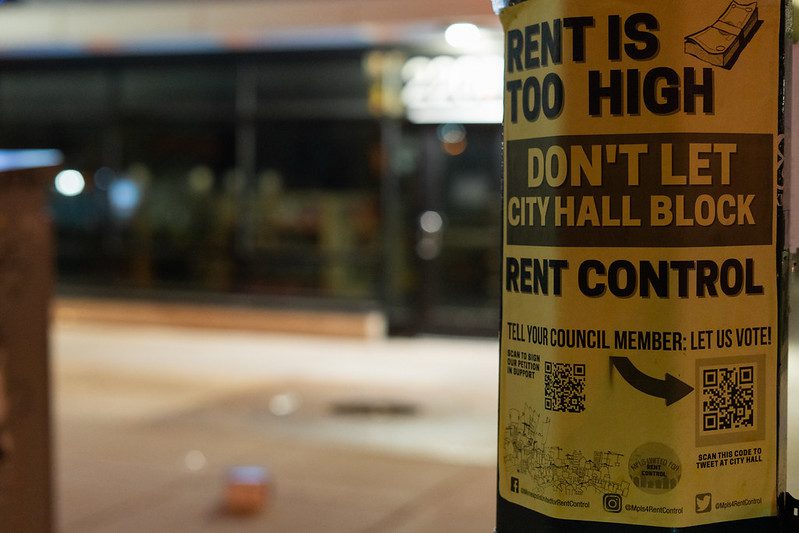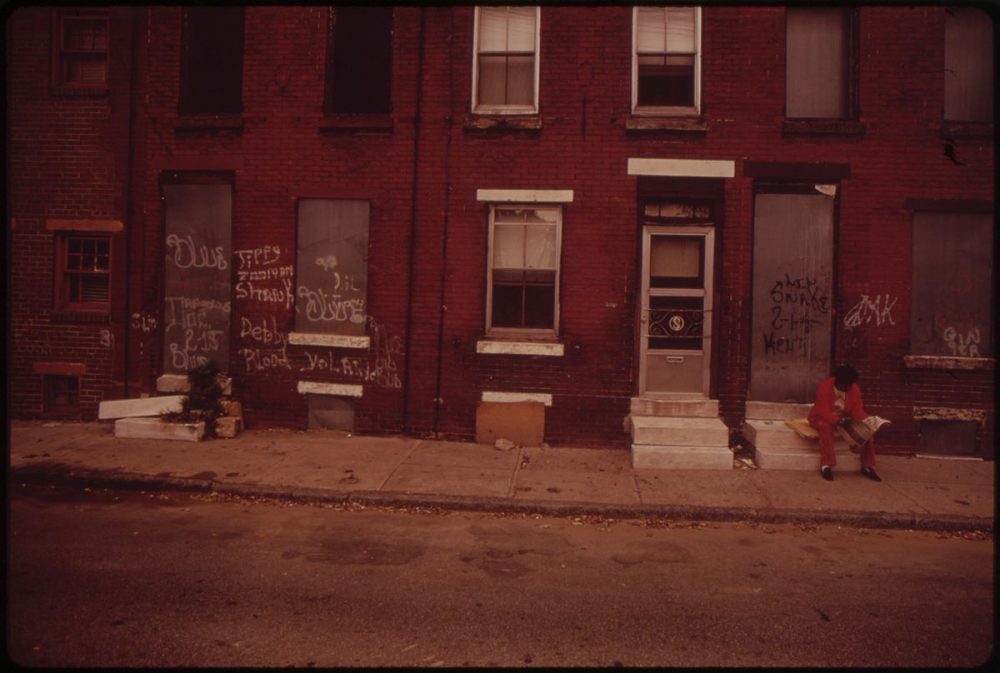
A “Rent is Too High” flyer in South Minneapolis. Photo by Flickr user Chad Davis, CC BY 2.0
Tenants won big in Minneapolis and St. Paul after ballot initiatives on rent stabilization passed by comfortable margins on Election Day.
In Minneapolis, voters approved a change to the city charter to allow the council to consider and enact rent stabilization. Minnesota, like many states, restricts the ability of local governments to consider and enact rent controls. Approval of the voters was necessary to allow the council to move forward.
In St. Paul, voters ratified a rent stabilization program designed by advocates, thereby skipping the step of city council deliberation and enactment. The St. Paul program will take effect in May 2022.
The two initiatives won despite an all-out effort by the housing industry to stop them. The industry raised and spent more than $4 million on a barrage of misleading and alarmist advertisements, promoted through mainstream media, social media, and mailings. Glossy mailers filled mailboxes in both cities proclaiming that “the experts” agree: rent control is a failed policy. But, in fact, the experts do not agree on that at all. The moderate forms of rent stabilization enacted in most U.S. cities have changed the conversation about rent regulations. Research bears out the assertion that the kinds of rent stabilization we have passed produce outcomes that are a far cry from the horror stories pushed by economists and industry representatives.
The St. Paul proposal was especially vulnerable to the scare tactics employed by opponents because it contains two features that are not common in moderate forms of rent stabilization. First, the amount by which a landlord can increase rent each year is not tied to inflation but instead is set at a flat 3 percent. Critics argued that this could seriously harm revenues, and in turn harm building upkeep, in periods of higher inflation. Supporters pointed to research showing that for most of the past 20 years in the Twin Cities, median rent increases and the rate of inflation were actually below 3 percent.
The second feature of the St. Paul program that opponents attacked was the fact that it does not exempt new construction. Opponents predicted that the program would thus kill new residential construction in the city. Advocates maintained that new construction was likely to continue since developers and owners remain free to set initial rents as high as they want them. Unlike most rent stabilization laws in this country, St. Paul’s also does not exempt rentals in single family housing or other small—2- to 4-unit—buildings.
In Minneapolis, because voters were not approving a specific program but rather simply granting the council the right to create a program, opponents attacked the council itself, playing on criticism the council has received over the past year or two as being divided, divisive, and ineffective. Mailers featured the “blank check” that voters would be giving the council if they approved the initiative. Opponents also made much of the fact that the council “had no plan” in place and had not made details available to voters ahead of time. The campaign warned against giving the city council “new powers,” telling voters that “you just can’t trust the City Council.”
With only a fraction of the resources amassed by opponents, advocates in both St. Paul and Minneapolis fashioned a grassroots effort that aimed to make direct contact with as many renters as possible.
Not only were renters outspent at a rate of 7 to 1 in this election, but historical patterns of voting behavior were also likely to work against them. Renters as a group vote at lower rates than do homeowners, and this election was an “off-cycle,” municipal-only election, with no high-profile state or national races or candidates to attract voters. In the end, however, none of this mattered. Turnout in Minneapolis was 54 percent, a record for an off-cycle municipal election. Voters were motivated by the presence of two other important local initiatives on the ballot, one to shift the city to a “strong mayor” system of governance, and another to create a Department of Public Safety that would replace the city’s Police Department. In St. Paul, the rent stabilization initiative was approved despite a 35 percent turnout there.
Rent stabilization won in Minneapolis even as other progressive causes, including the police initiative, lost decisively. In St. Paul, the measure was supported in the last weeks of the campaign by the mayor, Melvin Carter, himself up for reelection. Endorsements also came in from several other elected officials.
The wins are an indication of the vulnerability felt by tenants in the current housing market in both cities. Research I worked on had shown that the largest rent increases over the past 15 years had occurred at the bottom of the rental market. Renters in Minneapolis with incomes in the lowest quartile had experienced a 44 percent increase in rents between 2006 and 2019 while their incomes had increased by less than 3 percent. And though landlords and owners like to paint rent stabilization as a radical and dangerous intervention, for renters it seems more like common sense. As Jennifer Arnold, executive director of the tenant advocacy group Inquilinxs Unidxs Por Justicia (United Renters for Justice), told me during the campaign, “Rent stabilization is so basic that people think it already exists. I can’t tell you how many times our membership has called saying ‘hey, my rent just went up $300, how is that legal?’… It feels like [rent control] should already be there because it is so patently unfair to have such a huge rent increase.”
The Election Day results are not the end of the story. Despite the endorsements from elected officials, the St. Paul initiative was opposed by most of the city’s councilmembers. And after one year of operation the council will have an opportunity to amend or even rescind the program. In fact, even Mayor Carter, while indicating his support for the measure, stated only that he considers it “a good start” and one that might be improved through amendment down the line. It is likely that the flat cap on annual rent increases and the inclusion of new construction are elements of the program that might be targeted for change in the future.
In Minneapolis, the city council that was elected earlier this month is significantly different from the one that initiated the process to change the city charter. The council president, a strong supporter of rent stabilization, did not run for reelection, and three other supportive members were not reelected. Seven of the 13 seats on the council will be filled with newcomers. Now that the council has been given the authority to consider rent stabilization, it falls to a largely new group of legislators to iron out the details.




This article says,
“Supporters pointed to research showing that for most of the past 20 years in the Twin Cities, median rent increases and the rate of inflation were actually below 3 percent.”
Interesting that the researchers only went back 20 years. Had they gone back *40* years they would have seen me paying mortgages with interest of 11.75% around 1982.
And what about the current tsunami of price increases leading to an inflation rate of about 6%?
Twenty years is as far back as our data went; nothing nefarious about it. But, you are right, the current inflation will be a big test for the St. Paul ordinance and may likely contribute to calls for amending it, which the Council can do after it has been in operation for one year.
The ordinance should have tied allowable rent increases to the CPI, as is common with commercial leases I work with.
It will be fascinating to see how rent control plays out in St. Paul. As a housing provider in Wisconsin — where state law won’t allow localities to impose it — I actually welcome the opportunity to observe the effects from next door. I and other landlords I know often don’t raise rent for current tenants more than nominally — when there is a vacancy it is raised to market. So will St. Paul owners maybe immediately raise their rents by 6%, 10%, 15%(?) so they don’t get trapped with an under-market rental when the 3% limit kicks in next May?
Here’s an interesting scenario for Prof. Goetz to consider, assuming this were in St. Paul: I have a duplex in a Milwaukee suburb rented to two sisters. They have been there 5 years, their respective rents are at least $150 under market but past, infrequent rent raises have not been more than 3% because I value their steady payments and quiet lifestyle. Also, they are both on fixed incomes and couldn’t afford current median rent. But if they move I’d be stuck with the 3% cap for a new tenant and I would never get back to a market rate.
And what if I want to sell that property with the under-market rents? I’m going to get thousands less than market value because the new owner can’t raise rents enough to cover their mortgage. Or can the new owner ask permission for a substantial rent increase because he now has a much higher carrying cost? It seems maybe he can because the ordinance allows “a reasonable return on investment.” But that requires paperwork, a hearing in front of city bureaucrats and, worst of all, UNCERTAINTY. So the closing of my sale will be delayed and will be contingent on my purchaser first getting approval of the rents he needs to charge.
Will there be increased sales of rental properties by owners who won’t want the hassle of applying for municipal permission to exceed the 3% cap because rent losses due to evictions require an increase?
There have been predictions that owners will not improve their properties because capital costs can only be recovered through amortized increases when *necessary* as per Sec. 193A.05 of the ordinance. Here is another scenario: I have a single family, six bedrooms with two bathrooms, one has a shower but the other bathroom is antiquated, old tub and no shower. I have been thinking of renovating the old bathroom but it meets code so that cost would not qualify for a rent increase.
Gonna be fascinating to see how this all plays out . . .